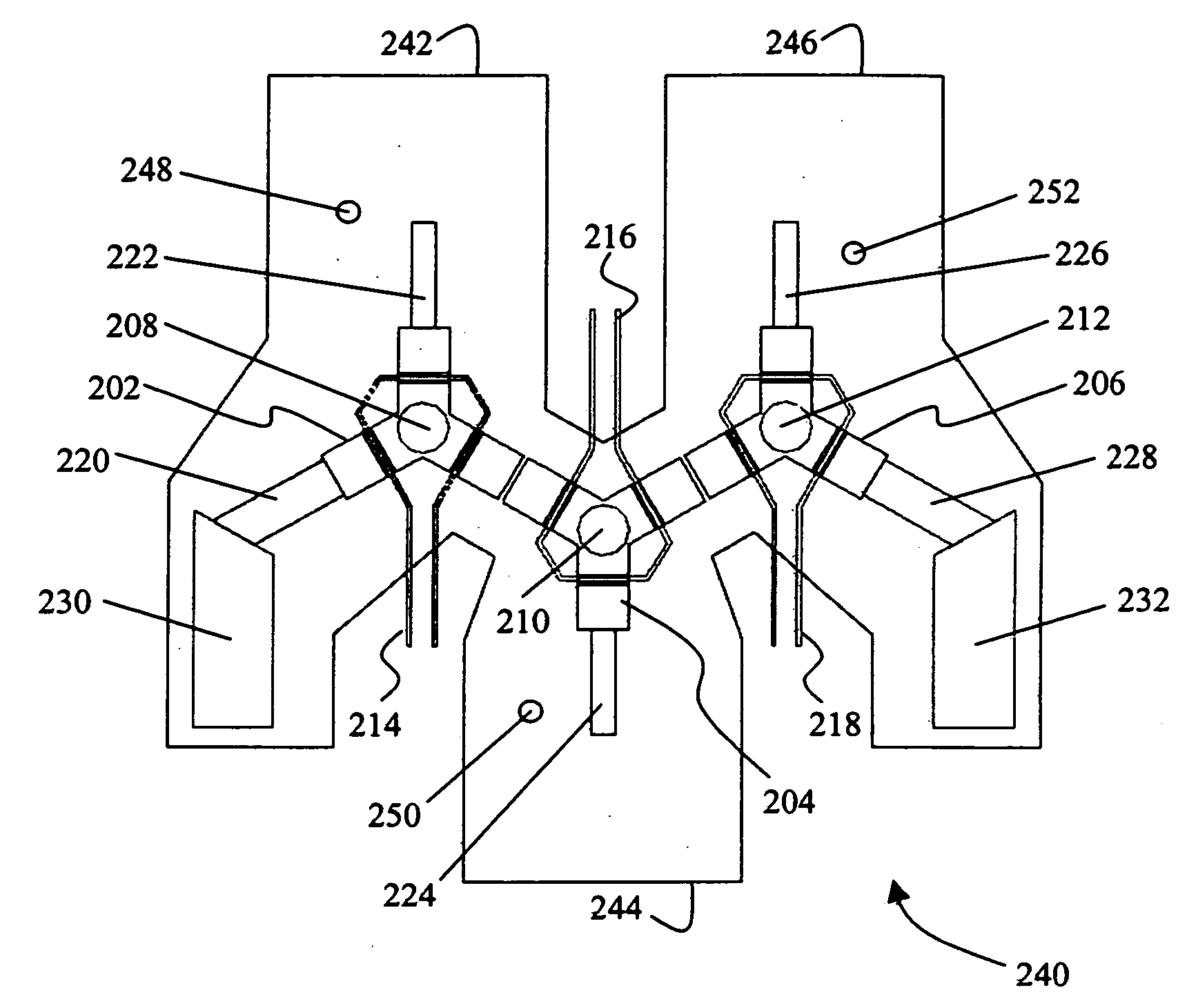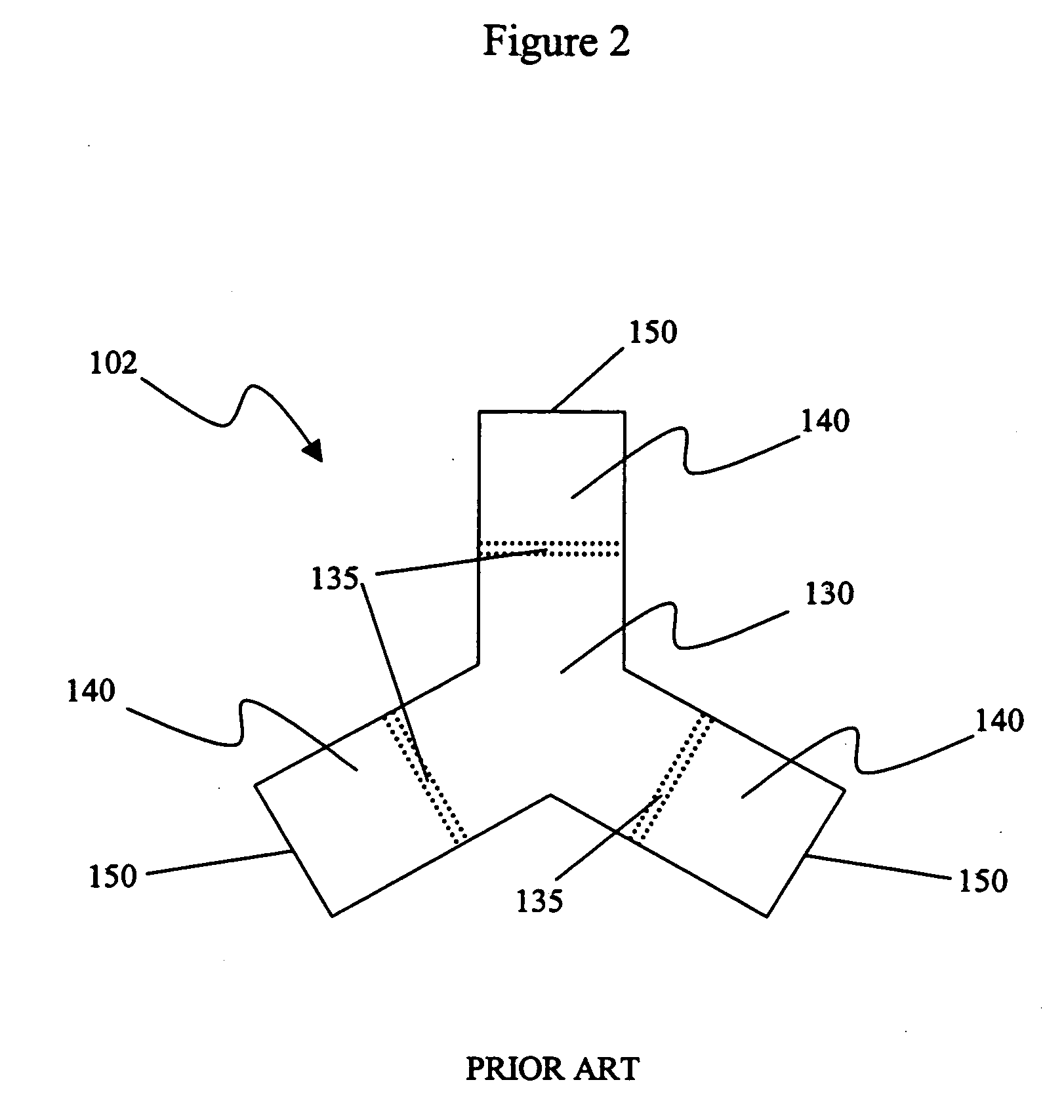Multi-junction waveguide circulator without internal transitions
a waveguide and circulator technology, applied in waveguide devices, basic electric elements, electrical apparatuses, etc., can solve the problems of increasing the design insertion loss, and achieve the effect of eliminating the transition out of the ferrite-loaded waveguide and eliminating the additional size and mass
- Summary
- Abstract
- Description
- Claims
- Application Information
AI Technical Summary
Benefits of technology
Problems solved by technology
Method used
Image
Examples
first embodiment
[0053]FIG. 3 shows a top view of a multi-junction waveguide circulator in accordance with the invention. This circulator configuration is referred to as a triad switch. A triad switch is comprised of a single switching circulator and two switching or non-switching isolators. The isolators are added to the switch so that the impedance match for any one port is independent of the impedance match on the other ports. Any signal reflections generated by mismatches at the other ports are absorbed in the absorptive load elements that are part of the isolators. It important to note that while the embodiments below illustrate the ferrite element as having a Y-shape with three legs, the invention also includes a variety of differing shapes, including a triangular puck or rectangular puck shape. While these shape may not be considered to have legs as described below, they nevertheless have a particularly protruding portions which may operate in a manner similar to the toroid legs described bel...
second embodiment
[0068]FIG. 11 shows opposing side walls 360 and 370 for the invention where W4 is the distance between these walls, and the distance W3 is the width of the legs of the ferrite elements 302 and 304. As in the embodiment of FIG. 4, for the Ka-band of operating frequency the preferred relationship between distances W3 and W4 is described as follows: W4 is no greater than 4×(multiplied) by W3 and W4 is no less than 2×(multiplied) by W3. However, it is understood that this dimensional relationship can be varied within the scope of the design of this invention, as required for optimum signal transfer with reduced loss and signal reflection. Also, in FIG. 4, there is no gap between the contact region between the two adjacent ferrite elements 302 and 304. Instead, as shown in FIG. 11, the two legs of ferrite elements 302 and 304 form a continuous piece that has no discontinuity.
third embodiment
[0069]FIG. 12 shows a multi-junction waveguide circulator. As was described earlier, the invention can be implemented in variations from a minimum of two ferrite circulator elements to any number of ferrite elements as may be required to achieve the desired isolation performance or to create a switch matrix with any combination of input and output ports. Without the compact size and low loss of this invention, multi-junction waveguide circulators such as that shown in FIG. 12 are not practical. FIG. 12 shows a conductive waveguide structure 400 containing of a plurality of ferrite elements disposed in a circular configuration. A quarter-wave dielectric ferrite-to-air transformer 412 is attached to a leg of ferrite element 410 to assist in the impedance matching between the ferrite element 410 and the input / output port 452. A magnetizing winding 415, also called a control wire, passes through ferrite element 410. Quarter-wave dielectric-to-load transformers 423 and 433 are attached t...
PUM
 Login to View More
Login to View More Abstract
Description
Claims
Application Information
 Login to View More
Login to View More - R&D
- Intellectual Property
- Life Sciences
- Materials
- Tech Scout
- Unparalleled Data Quality
- Higher Quality Content
- 60% Fewer Hallucinations
Browse by: Latest US Patents, China's latest patents, Technical Efficacy Thesaurus, Application Domain, Technology Topic, Popular Technical Reports.
© 2025 PatSnap. All rights reserved.Legal|Privacy policy|Modern Slavery Act Transparency Statement|Sitemap|About US| Contact US: help@patsnap.com



